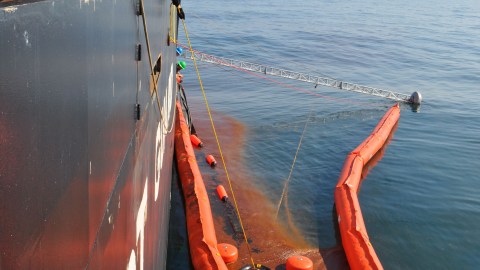BP: Beyond Primetime

Sick of hearing about a slow-moving sheet of oil floating about in the middle of the Gulf of Mexico? You may not be alone.
According to The New Republic‘s Bradford Plumer, the network coverage of the ongoing oil spill by doesn’t really stack up to past spills in either the amount of stories or in the minutes devoted to the crisis. “The Exxon Valdez spill in 1989 obviously got an enormous amount of coverage,” Plumer explains, “but it’s striking that even incidents like the 1978 Amoco Cadiz accident off the coast of France got far more media attention than the current BP spill.” Have viewers become so desensitized to corporate abuses that the repeated spills begin to blend into the background of destruction wrought by the likes of Enron, Lehman Brothers, Goldman Sachs, Dow Chemical, Halliburton, etc.? Or is the reason behind this relative lack of coverage something even more disheartening?
Plumer suggests it all has to do with “imagery”:
After the Exxon Valdez disaster, you had scores of images of ducks and otters slathered in crude. There were pictures of dead whales washed up against gleaming black rocky beaches. It was lurid—and impossible to ignore. By contrast, Brulle points out, not nearly as much oil from the BP accident has reached the shores of the Gulf Coast yet. Even groups like Greenpeace have only been able to rustle up a few pictures of a handful of ducks covered with oil. That’s not the sort of thing that drives TV coverage.
The public is lacking visuals. This despite the fact that this spill could be ultimately more damaging than the Exxon Valdez disaster—the editors of The Nation argue that it could be on track to being the largest oil spill in US history. Since the oil has yet to wash up on the mainland, the very real damages of the spill threaten to slip under the radar. Mentioning a front page story in the New York Times, “Bad. But an Apocalypse?”, Brett Norman of the Columbia Journalism Review perceptively points out that “lack of landfall could produce an out-of-sight, out-of-mind effect that could kill the investigative initiative that has emerged over the past several days.“
The lack of attention-catching images means media outlets have had to focus on other aspects of the crisis. Unfortunately, they’re now especially fond of one aspect that puts most viewers to sleep: the rate at which the oil is spilling into the ocean. BP has so far severely failed to halt the damage their spill is causing and, in fact, their cleanup efforts may be doing more harm than good. Therefore, the message that should be getting across to the public is that—much like greenhouse emissions, DDT, and other invisible-yet-deadly environmental dangers—believing should not and cannot depend on seeing.





